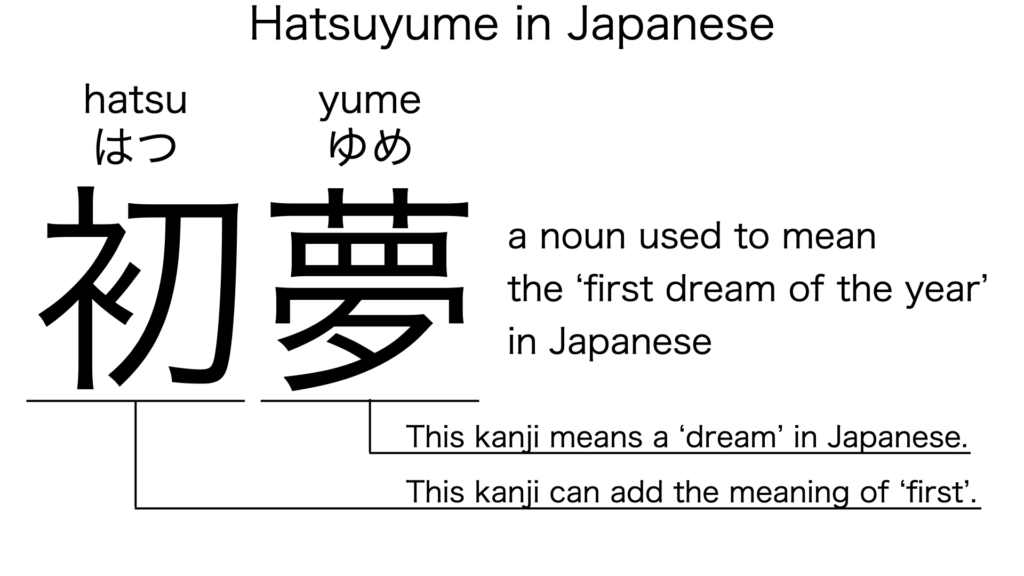What does “hatsuyume” mean in Japanese?
Native speakers use hatsuyume to mean the ‘first dream of the year’ in Japanese. Perhaps, some Japanese learners know this word as it is sometimes used in Japanese movies, songs, novels, manga, anime, and the like. In this blog post, however, I’m explaining this word in detail based on its kanji expression. And also, I’m explaining how to use it through example sentences. My explanations would help Japanese learners understand hatsuyume more clearly. Then, let’s get started!
Contents
Definition and meaning of “hatsuyume”
Let me start with the definition and meaning of hatsuyume.
- hatsuyume – 初夢 (はつゆめ) : a noun used to mean ‘the first dream of the year’ in Japanese.
The definition and meaning are simple and clear. To understand this noun more clearly, however, let me explain its kanji characters in detail, one by one.
Hatsuyume in kanji
The kanji expression of hatsuyume consists of the following two kanji characters:
- 初 : a kanji character often used as a prefix to add the meaning of ‘first’ in Japanese.
- 夢 : a kanji character used to mean a ‘dream’ in Japanese.
From these two kanji characters, we can understand that hatsuyume literally means the ‘first dream’ in Japanese. This literal interpretation is very close to the actual meaning.

When we meet new kanji expressions, we should check their kanji characters in detail to understand their meanings clearly and deeply. In many cases, kanji characters tell us a lot about the meanings of the expressions they form. Actually, here, we could get the better understanding of hatsuyume through the detailed kanji check above.
So far, I’ve explained the definition and meaning of hatsuyume together with its kanji characters. Then, let me explain how to use it through the example sentences below.
How to say “first dream of the year” in Japanese
kinou watashi wa hatsuyume wo mi ta – 昨日私は初夢を見た (きのうわたしははつゆめをみた)
I had the first dream of the year yesterday.
Below are the new words used in the example sentence.
- kinou – 昨日 (きのう) : a noun used to mean ‘yesterday’ in Japanese. This can also be used as an adverb almost anywhere in a sentence. In the example, this is used as an adverb at the beginning of the sentence to mean ‘yesterday’ in Japanese.
- watashi – 私 (わたし) : a pronoun used to mean ‘I’ in Japanese.
- wa – は : a binding particle working as a case marker or topic marker. In the example, this works after watashi to make the subject in the sentence.
- wo – を : a case particle used to make the object word in a sentence. In the example, this is used after hatsuyume to make the object in the sentence.
- mi – 見 (み) : one conjugation of the verb, miru, which means ‘to see’, ‘to watch’, ‘to look’, or such in Japanese. In the example, it has been conjugated for the better connection with its following word.
- ta – た : an auxiliary verb used after a verb, adjective, or auxiliary verb to make its past tense form. Probably, this is well known as a part of the Japanese ta form. In the example, this is used after mi to make its past tense form, mi ta.
This is a typical usage of hatsuyume. In this example, it works in the commonly-used phrase, hatsuyume wo mi ta, which means ‘had the first dream of the year’ in Japanese.
Another example of “hatsuyume”
boku wa hatsuyume wo omoidase nai – 僕は初夢を思い出せない (ぼくははつゆめをおもいだせない)
I cannot remember my first dream of the year.
Below are the new words used in the example sentence.
- boku – 僕 (ぼく) : a pronoun used to mean ‘I’ in Japanese. This is used mainly by boys and young males.
- omoidase – 思い出せ (おもいだせ) : one conjugation of the verb, omoidasu, which means ‘to remember’ in Japanese. In the example, it has been conjugated for the better connection with its following word.
- nai – ない : an auxiliary verb used after a verb, adjective, or auxiliary verb to deny its meaning. Probably, this is well known as a part of the Japanese nai form. In the example, this is used after omoidase to deny its meaning.
This is another example of hatsuyume. When we want to refer to the first dream of the year in Japanese, this noun is always a very good option.
Summary
In this blog post, I’ve explained the definition and meaning of hatsuyume in detail based on its kanji expression. And also, I’ve explained how to use it through the example sentences. Let me summarize them as follows.
- hatsuyume – 初夢 (はつゆめ) : a noun used to mean ‘the first dream of the year’ in Japanese. These two kanji characters literally mean the ‘first dream’ in Japanese. This literal interpretation is very close to the actual meaning.
Hope my explanations are understandable and helpful for Japanese learners.
Leave a Reply